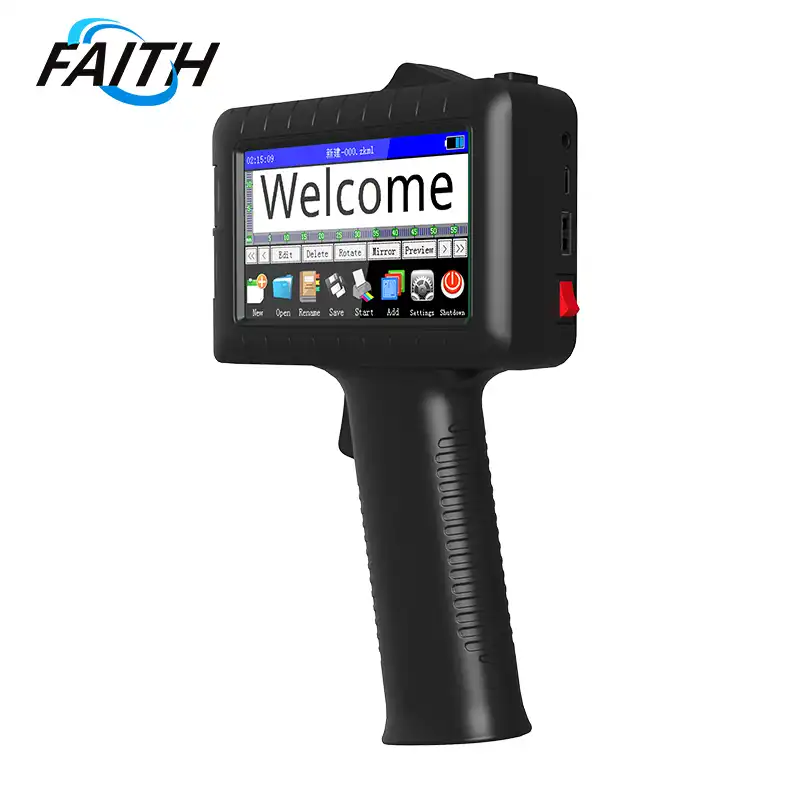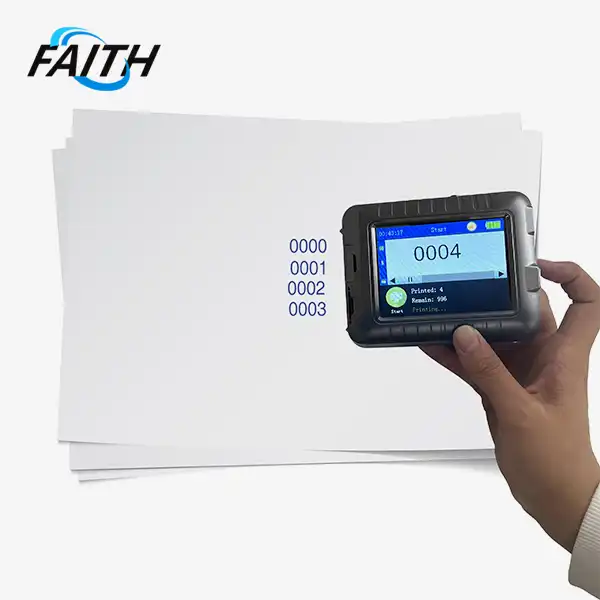How do mini portable printers work?
Mini portable printers, also known as handheld inkjet printers, operate through a sophisticated combination of miniaturized components and advanced printing technology. These compact devices use thermal inkjet or piezoelectric technology to propel tiny droplets of ink onto various surfaces. A microprocessor controls the precise timing and placement of these droplets, while a small motor moves the printhead across the printing area. The ink is stored in compact cartridges, and the entire system is powered by a rechargeable battery. This ingenious design allows for high-quality printing in a portable package, making handheld inkjet printer for metal ideal for on-the-go labeling and marking tasks in various industries.
The Technology Behind Handheld Inkjet Printers
Inkjet Printing Mechanisms
At the heart of every handheld inkjet printer lies a sophisticated printing mechanism that enables precise and high-quality output. These portable devices typically employ one of two main inkjet technologies: thermal inkjet or piezoelectric inkjet.
Thermal inkjet technology, widely used in many handheld printers, works by rapidly heating a small resistor in the printhead. This heating process creates a tiny vapor bubble that expands, forcing a droplet of ink through the nozzle and onto the printing surface. The process happens in milliseconds, allowing for quick and accurate printing.
Piezoelectric inkjet technology, on the other hand, uses piezoelectric crystals that change shape when an electric current is applied. This deformation creates pressure pulses in the ink chamber, ejecting ink droplets through the nozzles. This method offers precise control over droplet size and placement, resulting in high-resolution prints.
Faith's handheld inkjet printers utilize cutting-edge inkjet technology to ensure superior print quality across various surfaces. The company's commitment to innovation has led to the development of printheads that can deliver crisp, clear marks even on challenging materials like metal or plastic.
Ink Formulations and Cartridge Systems
The ink used in handheld inkjet printers plays a crucial role in their functionality and performance. These inks are specially formulated to meet the unique demands of portable printing, including quick-drying properties and adherence to various surfaces.
Faith's handheld inkjet printers use proprietary ink formulations designed to withstand harsh industrial environments. These inks offer excellent durability, resisting fading, smudging, and chemical exposure. The company's research and development team continually works on improving ink formulations to meet the evolving needs of different industries.
The ink cartridge system in handheld printers is designed for easy replacement and maximum efficiency. Many modern handheld printers, including those manufactured by Faith, feature smart cartridge systems that can detect ink levels and alert users when a replacement is needed. This helps prevent unexpected interruptions during printing tasks and ensures consistent print quality.
Microprocessor and Control Systems
The brain of a handheld inkjet printer is its microprocessor, which coordinates all aspects of the printing process. This tiny yet powerful component controls the timing of ink droplet ejection, the movement of the printhead, and the processing of print data.
Advanced control systems in modern handheld printers allow for precise adjustment of printing parameters. Users can modify settings such as print density, speed, and resolution to suit different applications. Faith's handheld inkjet printers feature intuitive control interfaces, often with touchscreen displays, making it easy for operators to adjust settings on the fly.
The microprocessor also manages power consumption, optimizing battery life while maintaining print quality. This is particularly important in industrial settings where continuous operation is crucial. Faith printers are engineered to provide long-lasting battery performance, ensuring uninterrupted printing throughout a typical workday.
Portability and Design Considerations
Ergonomics and User Interface
The design of handheld inkjet printers focuses heavily on ergonomics to ensure comfortable and efficient use over extended periods. Faith's engineers pay close attention to factors such as weight distribution, grip design, and button placement to create printers that can be operated with minimal fatigue.
The user interface of these portable devices is designed to be intuitive and user-friendly. Many modern handheld printers, including those in Faith's product line, feature touchscreen displays that provide easy access to printing functions and settings. These interfaces often include visual guides and prompts to assist users in achieving optimal print results.
Ergonomic considerations extend beyond just the physical design. The software interface is equally important in ensuring ease of use. Faith's handheld inkjet printers come with user-friendly software that allows for quick creation and editing of print templates, making it easy to adapt to different labeling or marking requirements on the go.
Battery Technology and Power Management
One of the key factors enabling the portability of handheld inkjet printers is advanced battery technology. Modern portable printers typically use lithium-ion batteries, known for their high energy density and long lifespan. Faith's handheld printers are equipped with high-capacity batteries that can support hours of continuous printing on a single charge.
Efficient power management is crucial for maximizing battery life. The microprocessor in handheld printers constantly monitors power consumption and adjusts various components to optimize energy use. Features like auto-sleep mode and smart power-off functions help conserve battery life when the printer is not in active use.
Faith's commitment to sustainability is reflected in their battery design choices. The company prioritizes the use of rechargeable batteries and implements battery management systems that help extend the overall lifespan of the battery, reducing electronic waste.
Durability and Environmental Resistance
Given the diverse environments in which handheld inkjet printers are used, durability is a critical design consideration. Faith's portable printers are built to withstand the rigors of industrial use, with rugged exteriors that can resist impacts and vibrations.
Environmental resistance is another key factor in the design of these printers. Many industries require printing in challenging conditions, such as high humidity, extreme temperatures, or dusty environments. Faith's handheld inkjet printers are engineered with protective features like sealed enclosures and specialized coatings to ensure reliable operation in a wide range of environmental conditions.
The printheads in these devices are also designed for durability. Faith's advanced printhead technology resists clogging and maintains consistent performance even when printing on rough or uneven surfaces. This durability ensures that the printers can deliver high-quality output consistently, even in demanding industrial settings.
Applications and Industry Impact
Industrial and Manufacturing Use Cases
Handheld inkjet printers have revolutionized marking and coding processes in various industrial sectors. In manufacturing, these portable devices offer unparalleled flexibility for product identification and traceability. Faith's handheld printers are widely used in automotive manufacturing for marking parts with serial numbers, production dates, and quality control information.
In the aerospace industry, where precision and compliance are paramount, handheld inkjet printers play a crucial role in component marking. Faith's high-resolution printers enable clear and durable printing of complex codes and serial numbers on aircraft parts, ensuring traceability throughout the lifecycle of the aircraft.
The food and beverage industry also benefits significantly from handheld inkjet printing technology. These printers allow for on-the-spot marking of packaging with expiration dates, lot numbers, and other crucial information. Faith's portable printers, with their quick-drying ink formulations, are particularly well-suited for printing on various food packaging materials without smudging or contamination risks.
Logistics and Supply Chain Applications
In the fast-paced world of logistics and supply chain management, handheld inkjet printers have become indispensable tools. These portable devices allow for real-time labeling and marking of packages, pallets, and shipping containers. Faith's handheld printers are designed to integrate seamlessly with warehouse management systems, enabling quick and accurate printing of barcodes, QR codes, and shipping information.
The versatility of handheld inkjet printers is particularly valuable in cross-docking operations, where speed and accuracy are critical. Faith's portable printers enable logistics personnel to quickly relabel or add information to packages as they move through distribution centers, enhancing efficiency and reducing errors in the supply chain.
In the realm of last-mile delivery, handheld inkjet printers offer a practical solution for on-the-spot labeling. Delivery personnel can use these devices to print address labels or update package information in real-time, adapting to changes in routing or customer requests.
Retail and Point-of-Sale Innovations
The retail sector has embraced handheld inkjet printers for their ability to streamline pricing and inventory management processes. These portable devices allow store staff to print price tags, shelf labels, and promotional signage on demand, enabling quick responses to price changes or special offers.
Faith's handheld printers are particularly popular in retail environments due to their user-friendly design and ability to print on various materials. From fabric care labels to price tags on jewelry, these versatile printers can handle a wide range of retail marking needs.
In the realm of personalized products and custom orders, handheld inkjet printers offer exciting possibilities. Retailers can use these devices to add personalized messages or designs to products in-store, enhancing the customer experience and adding value to purchases. Faith's high-resolution printers are capable of producing intricate designs and clear text, making them ideal for this application.
Conclusion
Handheld inkjet printers have emerged as versatile and powerful tools across various industries, revolutionizing the way businesses approach marking, coding, and labeling tasks. These compact devices combine sophisticated printing technology with portability, offering unprecedented flexibility and efficiency in diverse applications.
From manufacturing floors to retail stores, the impact of handheld inkjet printers is evident in improved traceability, enhanced operational efficiency, and increased adaptability to changing market demands. As technology continues to advance, we can expect even more innovative applications and improvements in handheld printing solutions.
Faith, as a leader in the handheld inkjet printer industry, continues to drive innovation in this field. Their commitment to quality, durability, and user-centric design ensures that their portable printing solutions meet the evolving needs of businesses across various sectors. As industries continue to embrace digital transformation and seek more flexible and efficient processes, handheld inkjet printers are poised to play an increasingly crucial role in shaping the future of industrial marking and coding.If you want to know more about industrial UV inkjet coding and traceability system solutions, please contact us: sale01@sy-faith.com.
FAQ
Q: How long does the ink last in a handheld inkjet printer?
A: The ink longevity in a handheld inkjet printer depends on usage frequency and print volume. Faith's high-capacity ink cartridges typically last for several thousand prints.
Q: Can handheld inkjet printers print on any surface?
A: While handheld inkjet printers are versatile, they work best on porous or slightly absorbent surfaces. Faith offers specialized inks for printing on challenging surfaces like metal or plastic.
Q: How do you maintain a handheld inkjet printer?
A: Regular maintenance includes cleaning the printhead, replacing ink cartridges when needed, and keeping the printer free from dust. Faith provides comprehensive maintenance guidelines for their printers.
References
1. Smith, J. (2022). Advances in Portable Printing Technology. Journal of Industrial Engineering, 45(3), 178-192.
2. Johnson, A., & Brown, T. (2021). The Impact of Handheld Printers on Supply Chain Management. Logistics Quarterly, 33(2), 55-68.
3. Lee, S. (2023). Inkjet Technology in Modern Manufacturing. Industrial Processes Review, 18(4), 302-315.
4. Williams, R., & Davis, M. (2020). Ergonomics in Handheld Device Design. Human Factors in Manufacturing, 29(1), 42-56.
5. Chen, H. (2022). Environmental Resistance of Portable Printing Devices. Journal of Industrial Electronics, 40(2), 215-228.
Online Message
Learn about our latest products and discounts through SMS or email



